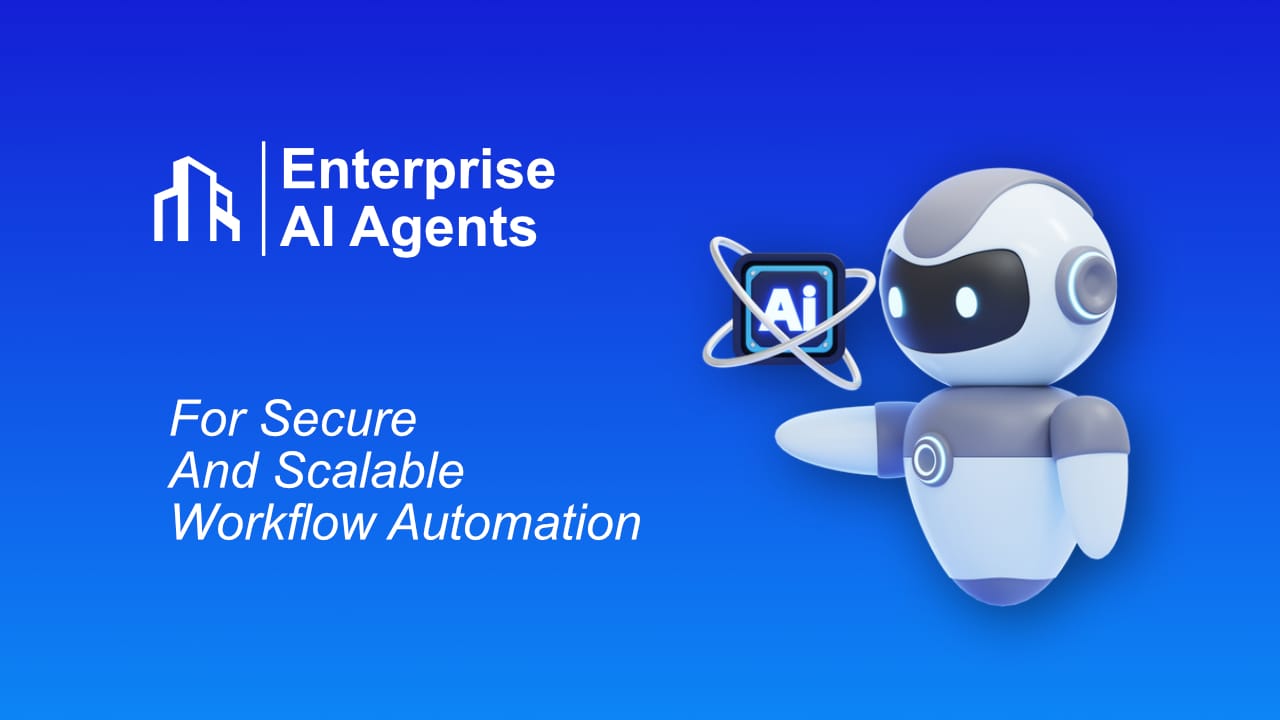Enterprise AI Agents for Scalable Automation, Compliance and Intelligent Workflows
Enterprise AI agents are becoming the execution layer for digital operations. This guide explains what they are, how they work, the leading platforms in the market and how to approach governance and compliance without unnecessary risk.

Enterprise AI adoption is entering a phase where conversational interfaces are no longer the full story. The focus is shifting to autonomous and semi autonomous agents that can plan, execute, monitor and improve digital workflows across business systems. Enterprise AI agents operate as digital workers that combine reasoning, context awareness, tool usage, browser interaction and business logic. They promise a future with fewer repetitive tasks, data informed decisions and more scalable processes without scaling human headcount at the same speed.
This article outlines what enterprise AI agents are, what problems they solve, which platforms are gaining relevance, how they can be used across business functions and how to manage compliance, security and governance. The goal is to provide a practical and strategic perspective for leaders, architects, security teams and transformation professionals.
What Enterprise AI Agents Are
An enterprise AI agent is a software based digital worker that can understand goals, plan the required steps, select the correct tools or systems, take actions, validate results and learn from feedback. Unlike simple automations that follow predefined steps, an AI agent can reason about the situation and adapt its workflow based on context.
Most enterprise agent frameworks integrate four core components
- Reasoning engine for decisions and planning
- Tool orchestration layer for APIs and browser actions
- Memory and context preservation for continuity
- Safety and escalation logic for boundaries and review
The key strength of AI agents is their ability to operate beyond static rule based automation by incorporating natural language understanding, knowledge grounding and dynamic adaptation.
Enterprise Use Cases
Knowledge automation
Agents convert unstructured content into structured formats, answer questions based on internal reference material and provide summarised insights for decision making.
Frontline support
Agents can work as first line support inside CRM or ticketing systems and escalate when required. They can also draft responses and detect intent with high accuracy.
Research and market intelligence
Agents extract insights from public and private sources, monitor competitor moves and prepare digestible outputs for strategy teams.
Operational workflow execution
Agents can log activities in CRM systems, update databases, enrich records, create tasks, check conditions and report anomalies.
AI browser operations
With platforms like Browserbase or similar cloud browser environments, agents can interact with user interfaces when the required data is not accessible through an API.
Compliance automation
Agents can monitor mandatory processes, generate audit ready documentation, detect missing data and support evidence collection.
Leading Platforms and Architectures
The enterprise AI agent landscape is evolving quickly. These categories represent current directions.
Foundation model agent runtimes
OpenAI, Anthropic and Google are enabling agent behaviour through models that handle planning and tool usage while developers integrate external systems. These runtimes are suitable for custom enterprise solutions.
Agent toolchains and orchestration layers
Platforms like LangChain and LlamaIndex provide frameworks for planning, memory and tool interaction. They require engineering capability but provide strong flexibility.
Fully managed agent execution platforms
Products such as Cognition Labs Devin, CrewAI and others focus on tangible agent workflows including task management and collaboration. These platforms target faster deployment rather than infrastructure control.
Browser and UI execution layers
Tools like Browserbase enable agents to interact with real interfaces. They help extend automation capabilities when no API is available.
Process automation platforms with AI extensions
Make, n8n and Zapier are increasingly adding AI modules that allow hybrid agent plus automation solutions.
There is no single best platform. Enterprises should evaluate based on data sensitivity, compliance needs, integration complexity, internal skills and ownership strategy.
Architecture Considerations
A stable enterprise AI agent architecture benefits from a layered approach
- Identity and access layer
- Reasoning and planning engine
- Tool execution layer
- Data validation and monitoring
- Audit and reporting
Avoid embedding business logic directly in the agent prompts. Keep logic modular and observable. This increases maintainability and auditability.
Governance and Compliance Requirements
AI agents increase operational capability but also introduce new risk categories. The following principles are essential for safe deployment.
Deterministic boundaries
Agents must only operate within approved systems and allowed functions. Define hard limits at execution level rather than prompt level.
Approval layers
High impact actions such as financial transfers, contract changes or account termination must always require human approval.
Data classification
Ensure that sensitive or regulated data is never shared with external dependencies unless approved by legal and security functions.
Session level logging
Store execution logs, decisions, tool usage and validation results. Make sure these logs are immutable and centrally accessible.
Performance and trust metrics
Track accuracy, false positives, false negatives, response quality and stability over time. Agents should be monitored similar to production grade software.
Practical Implementation Advice
Start with narrow scope use cases and expand only when stability and measurable impact are proven. Establish standard frameworks for prompts, tool access and validation. Integrate performance monitoring, version control and fallback systems. Treat agents as digital employees with job descriptions, permissions, training cycles and evaluation criteria.
Conclusion
Enterprise AI agents are becoming an operational necessity rather than a research experiment. They represent the next evolution in digital automation by combining reasoning, execution and adaptation. Successful adoption requires a balance of innovation, governance, platform selection and careful rollout. Companies that move early with structured and secure implementations will gain a competitive advantage through efficiency, resilience and operational scale.
For support with strategy, implementation or compliance aligned execution
